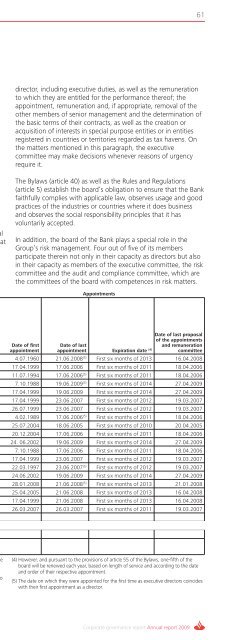You also want an ePaper? Increase the reach of your titles
YUMPU automatically turns print PDFs into web optimized ePapers that Google loves.
123The pace of growth in savings in the whole financial systemaccelerated and lending slowed down, which continued toimprove the quality of its balance sheet and maintain high levelsof liquidity.The Group’s strategy in <strong>2009</strong> was focused on lifting the returnon its business franchise, with greater importance attached tocustomer linkage and transaction banking, selective growth inlending and carefully managing the whole risk cycle. The lowergrowth in business required restrictive criteria in spending.Lending increased 2% and savings 13%. Deposits grew 15%(+32% demand deposits and +2% time deposits). Mutual fundsincreased 1%.Gross income rose 27.9% in local currency and net operatingincome 31.4%, fuelled by better spreads on lending. Net feeincome increased 19.2% and gains on financial transactions74.9%, largely due to better results in treasury.Operating expenses rose 10.9%, below the growth in grossincome. As a result, net operating income was 43.5% higher.Loan-loss provisions were 41.0% higher than in 2008 but on adownward trend. Profit before tax grew 48.0%, but attributableprofit was EUR 226 million, only 16.9% higher in local currency,because of the large rise in taxes.The efficiency ratio was 41.4%, the recurrence ratio 95.2% andROE 55.9%. The NPL ratio was 2.60% and coverage 141%.The priorities in 2010 are to make the commercial franchise moreprofitable through customer linkage, higher spreads on loans,selective growth in low risk assets, maintaining comfortable levelsof liquidity, carefully overseeing risk and controlling costs.UruguayAfter the incorporation of ABN businesses, <strong>Santander</strong> becamethe largest private sector bank in the country in terms of profits(EUR 51 million), number of branches (42) and business (marketshare of 17.0% in lending and 17.4% in savings). Thirty twopercent of the 258,000 customers are linked.Uruguay was one of the countries to emerge from recession in<strong>2009</strong>, as its economy only shrank in the first quarter. Growth forthe whole of <strong>2009</strong> was estimated at close to 2% and the forecastfor 2010 is more than 4%, with a moderate rise in inflation.In <strong>2009</strong>, growth in the financial system’s deposits and lendingslowed down, although it accelerated in the fourth quarter.The strategy in <strong>2009</strong> focused on exploiting the synergies fromthe merger of <strong>Santander</strong> and ABN; pushing retail business andgrowing and linking the number of individual customers, SMEsand companies. Also aiming to linkage and boosting of mediumand high income customers through its Van Gogh project.Lending and deposits declined by 15% and 8%, respectively,while gross income tripled, costs increased 126.1% (in bothcases with the perimeter impact) and loan-loss provisions weremarginal.The efficiency ratio was 54.0% and recurrence 29.9%. The NPLratio was 0.60% and coverage very high, showing another ofthe strengths of the new Bank.In 2010, the Group will focus on completing the technologicaland operational merger of <strong>Santander</strong> and ABN; fomenting retailbusiness, with a strong rise in linked customers from mediumand high income segments; greater business with companiesand achieving the best return on surplus liquidity.ColombiaAttributable profit was 29.0% higher in local currency at EUR 33million. The Group has 77 branches, 402,000 customers andmarket shares of 2.9% in businessThe economy hardly grew in <strong>2009</strong>. The impact of theinternational crisis on exports and consumer and businessconfidence hurt growth in the first half. In the second half of theyear, activity picked up a little. GDP growth is estimated at 3% in2010.The Group focused on credit risk management, selective growthin lending, preserving adequate levels of liquidity, strengtheningtransactional businesses and, in particular, containment of costs.The efficiency ratio was 57.8% and the recurrence ratio 43.9%.The NPL ratio was 1.83% and coverage 188%.In 2010, the emphasis is on selective business growth,preserving adequate levels of liquidity and customer linkage inrelevant segments.Puerto Rico<strong>Santander</strong> Puerto Rico is one of the island’s largest financialgroups, with 130 branches, 530,000 customers (18% of themlinked) and market shares of 8.3% in loans, 9.3% in depositsand 23.0% in mutual funds.The economy remained in recession, affecting both the growthof the financial system and its profitability, under pressure fromlower activity and higher risk premiums.In this environment, the bank continued to position itself amongthe three largest financial institutions in terms of lending,deposits and mutual funds. It continued to strengthen creditrecovery management and selective growth in business withindividuals and companies. This strategy, together with the11.7% reduction in costs, and the lower loan-loss provisionsproduced attributable profit of EUR 33 million (a loss of EUR 19million in 2008) and made it an exception in the banking systemas a whole.The efficiency ratio was 50.4%, the recurrence ratio 41.4%, theNPL ratio 9.6% and coverage 53%.The centre of attention in 2010 is selective growth in variousbusinesses, lower costs, loan loss recoveries and the sale ofassets assigned.PeruActivity was focused on companies and tending to the Group’sglobal customers. Attributable profit was EUR 4 million which,while modest, shows a favourable trend (EUR 1 million profit in2008).Economic and Financial Review<strong>Annual</strong> Report <strong>2009</strong>
















